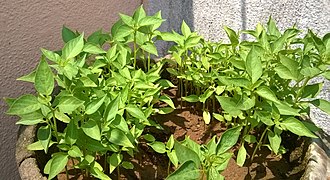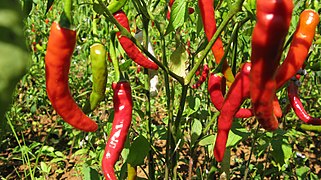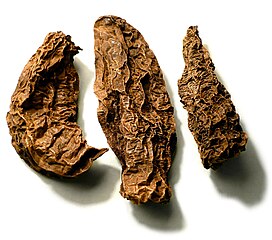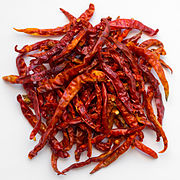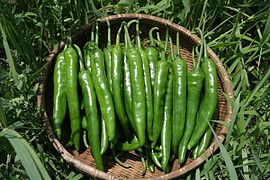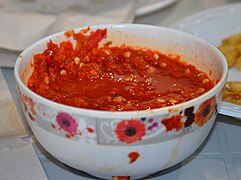Chili pepper/ja: Difference between revisions
Created page with "===抑制されたリスクテイキング===" |
No edit summary Tags: Mobile edit Mobile web edit |
||
| (13 intermediate revisions by the same user not shown) | |||
| Line 115: | Line 115: | ||
トウガラシを生産する''[[Capsicum/ja|Capsicum]]''属の種を、簡略化された[[phylogenetic tree/ja|系統樹]]と品種の例で示す。[[:en:World Vegetable Center|世界野菜センター]]は、世界でも有数のトウガラシのコレクションを保有している。同センターは、[[:en:climate change|気候変動]]に強い品種の研究を行ってきた。 | トウガラシを生産する''[[Capsicum/ja|Capsicum]]''属の種を、簡略化された[[phylogenetic tree/ja|系統樹]]と品種の例で示す。[[:en:World Vegetable Center|世界野菜センター]]は、世界でも有数のトウガラシのコレクションを保有している。同センターは、[[:en:climate change|気候変動]]に強い品種の研究を行ってきた。 | ||
{{clade | {{clade | ||
|label1='''''[[Capsicum/ja|Capsicum]]''''' | |label1='''''[[Capsicum/ja|Capsicum]]''''' | ||
| Line 136: | Line 135: | ||
}} | }} | ||
|2=''C. lycianthoides'' | |2=''C. lycianthoides'' | ||
}} | |||
}} | }} | ||
<gallery mode="packed" caption="品種"> | <gallery mode="packed" caption="品種"> | ||
| Line 255: | Line 254: | ||
File:Lamb Chops With Guajillo Chili Sauce and Charro Beans (cropped).jpg|[[guajillo/ja|ワヒージョ]]チリソースとチャロ豆を添えたメキシコ風ラムチョップ | File:Lamb Chops With Guajillo Chili Sauce and Charro Beans (cropped).jpg|[[guajillo/ja|ワヒージョ]]チリソースとチャロ豆を添えたメキシコ風ラムチョップ | ||
File:Taj Mahal - Lamb Curry Madras.jpg|ラム肉の[[Madras curry/ja|マドラスカレー]] | File:Taj Mahal - Lamb Curry Madras.jpg|ラム肉の[[Madras curry/ja|マドラスカレー]] | ||
File: | File:Chilli pickle in a plate 2.jpg|インドのチリのピクルス | ||
File:Chili pepper dip Amman.JPG|ヨルダンのアンマンにある伝統的なレストランのチリペッパーディップ | File:Chili pepper dip Amman.JPG|ヨルダンのアンマンにある伝統的なレストランのチリペッパーディップ | ||
File:Tinolang Manok.jpg|[[Filipino cuisine/ja|フィリピン料理]]の鶏肉スープ「[[tinola/ja|ティノーラ]]」と「[[labuyo/ja|ラプヨ]]」チリの葉 | File:Tinolang Manok.jpg|[[Filipino cuisine/ja|フィリピン料理]]の鶏肉スープ「[[tinola/ja|ティノーラ]]」と「[[labuyo/ja|ラプヨ]]」チリの葉 | ||
| Line 276: | Line 275: | ||
===抑制されたリスクテイキング=== | ===抑制されたリスクテイキング=== | ||
心理学者の[[:en:Paul Rozin|ポール・ローザン]]は、普通のトウガラシを食べることは、[[:en:roller coaster|ジェットコースター]]に乗るような「抑制されたリスク」の一例だと提唱している。これは、痛みや恐怖といった極端な感覚を、それが実際には無害であることを知っているため楽しむことができるというものである。この方法により、人々は身体に重大な危害を加えるリスクなしに、極端な感情を体験することができる。 | |||
< | <span id="Topical_use_and_health_research"></span> | ||
=== | ===局所使用と健康研究=== | ||
トウガラシに含まれる[[pungency/ja|辛味]]成分である[[Capsaicin/ja|カプサイシン]]は、[[analgesic/ja|鎮痛剤]]として[[topical medication/ja|局所軟膏]]、[[nasal spray/ja|点鼻薬]]、[[dermal patch/ja|貼付剤]]に用いられ、痛みを和らげるために使用される。2022年の予備研究のレビューでは、トウガラシの定期的な摂取が、[[cardiovascular disease/ja|心血管疾患]]や[[cancer/ja|がん]]による死亡リスクの低下と弱い証拠で関連付けられた。 | |||
[[ | |||
< | <span id="Chemical_irritants"></span> | ||
=== | ===化学的刺激物=== | ||
{{further/ja|Pepper spray/ja|Chili grenade/ja}} | |||
{{further|Pepper spray|Chili grenade}} | |||
トウガラシから抽出されたカプサイシンは、[[pepper spray/ja|催涙スプレー]]や一部の[[tear gas/ja|催涙ガス]]配合剤に化学的刺激物として使用され、手に負えない個人や群衆を制御するための[[:en:less-lethal weapon|非致死性兵器]]として用いられる。このような製品は誤用の可能性がかなり高く、負傷や死亡を引き起こす可能性がある。 | |||
[[:en:Human–wildlife conflict|農民とゾウの衝突]]は、[[:en:List of sovereign states and dependent territories in Africa|アフリカ]]や[[:en:List of sovereign states and dependent territories in Asia|アジア]]の国々で長年広範にわたっており、ゾウは夜間に作物を破壊し、穀物倉庫を襲撃し、時には人々を殺害する。農民は、ゾウに対する作物の防御にトウガラシが効果的であることを発見している。ゾウは、その大きく敏感な[[Olfaction/ja|嗅覚]]および鼻のシステムにより、カプサイシンを好まない。トウガラシの匂いはゾウに不快感を与え、作物を食べるのを思いとどまらせる。貴重な作物の周りに数列のトウガラシを植えることで、農民はゾウが通りたがらない緩衝地帯を作り出す。チリ糞爆弾もこの目的で使用される。これらは糞とチリを混ぜて作ったレンガで、燃やすと有害な煙を発生させ、空腹のゾウを農民の畑から遠ざける。これにより、人々とゾウの間の危険な物理的衝突を減らすことができる。 | |||
[[Human–wildlife conflict| | |||
鳥類は哺乳類と同じくカプサイシンに対する感受性を持たない。これは、特定の[[Nociceptors/ja|痛覚受容体]]を欠いているためである。トウガラシは、その自然な生息域に生息する鳥類によって食べられ、これは種子の散布とトウガラシにおける防御的なカプサイシンの進化に寄与している可能性がある。なぜなら、飛んでいる鳥は、陸上や樹上に生息する哺乳類が同じ状況下で行うよりも、親植物から遠く離れた場所に種子を散布できるため、資源をめぐる競争が減少するからである。 | |||
< | <span id="Etymology_and_spelling"></span> | ||
== Etymology and spelling == | ==語源と綴り{{Anchor|Etymology and spelling}}== | ||
英語の単語は{{etymology|nci|{{wikt-lang|nci|chīlli}}|}}であり、同じ意味を持つ。この植物の名称は、国名である[[:en:Chile|チリ]]とは無関係である。''pepper''という言葉は元々[[Piper (genus)/ja|コショウ属]]を意味し、トウガラシ属を意味しなかったが、『[[:en:Oxford English Dictionary|オックスフォード英語辞典]]』や『[[:en:Merriam-Webster|メリアム=ウェブスター]]』は両方の用法を記録している。 | |||
主な綴りは''chili''、''chile''、''chilli''の3つであり、いずれも辞書で認められている。 | |||
* 「Chili」は[[:en:United States|米国]]の英語で広く使われている。 | |||
* 「Chile」はメキシコやその他いくつかの中南米諸国、および米国の一部で最も一般的なスペイン語の綴りである。 | |||
* | * 「Chilli」は果実を表す[[:en:Nahuatl|ナワトル語]]の単語(chīlli)の元々の[[:en:Romanization|ローマ字表記]]であり、『[[:en:Oxford English Dictionary|オックスフォード英語辞典]]』によると英国で好まれる綴りである。「Chilli」(および複数形「chillies」)は、インドやスリランカなどの旧英国植民地で最も一般的な綴りである。 | ||
* | |||
< | <span id="Safety"></span> | ||
== Safety == | ==安全性{{Anchor|Safety}}== | ||
[[volatile oil/ja|揮発性油]]を含むトウガラシは皮膚刺激を引き起こす可能性があり、目やその他の敏感な身体部位に触れる際には手洗いと注意が必要である。辛いトウガラシを摂取すると、胃痛、[[hyperventilation/ja|過呼吸]]、[[sweat/ja|発汗]]、[[vomit/ja|嘔吐]]、および場合によっては入院が必要となる症状を引き起こす可能性がある。 | |||
悪質な業者は、[[:en:Auramine O|オーラミンO]]、[[:en:Chrysoidine|クリソイジン]]、[[:en:Sudan stain|スーダン色素IからIV]]、[[:en:Para red|パラレッド]]、[[:en:Rhodamine B|ローダミンB]]を含む少なくとも8種類の合成染料を違法にトウガラシ製品に添加してきた。これらの化学物質はすべて有害である。これらは[[:en:mass spectrometry|質量分析法]]と組み合わせて使用される[[:en:liquid chromatography|液体クロマトグラフィー]]によって検出できる。 | |||
< | <span id="In_popular_culture"></span> | ||
== In popular culture == | ==大衆文化において{{Anchor|In popular culture}}== | ||
[[File:Capsicum -Chili - Peperoncino - Il Viagra Calabrese - Calabria - Italy - July 17th 2013 - 02.jpg|thumb|イタリアの[[Peperoncino/ja|ペペロンチーノ]]唐辛子、[[aphrodisiac/ja|媚薬]]として宣伝されている]] | |||
[[File:Capsicum -Chili - Peperoncino - Il Viagra Calabrese - Calabria - Italy - July 17th 2013 - 02.jpg|thumb|[[Peperoncino]] | |||
16世紀のスペインの宣教師で博物学者であった[[:en:José de Acosta|ホセ・デ・アコスタ]]は、トウガラシの[[aphrodisiac/ja|媚薬]]としての効能に言及したが、それらは人々の[[spiritual health/ja|精神的な健康]]に有害であると記している。1970年代、ペルー政府は受刑者がトウガラシを摂取することを禁じたが、その理由は「限られた生活を送る男性には適切ではない」というものであった。 | |||
<span id="See_also"></span> | <span id="See_also"></span> | ||
Latest revision as of 11:30, 10 June 2025

トウガラシ(英: chili peppers、チリまたはチリとも綴られる、from Classical Nahuatl chīlli nah)は、ナス科ナス属のトウガラシ属(Capsicum)に属する液果植物の品種で、その辛味のために栽培される。多くの料理でスパイスとして辛味を加えるために使用される。カプサイシンおよび関連するカプサイシノイドは、摂取時または局所塗布時にトウガラシにその辛味を与える。トウガラシは様々な辛さと風味を示す。この多様性により、チリパウダーには様々な種類があり、それぞれが独自の味と辛さレベルを提供している。
トウガラシは中央アメリカまたは南アメリカが原産で、メキシコで最初に栽培された。ヨーロッパの探検家たちは16世紀後半にコロンブス交換の一環としてトウガラシを旧世界に持ち帰り、それが世界中で食品や伝統医学のために様々な品種が栽培されるきっかけとなった。5つのトウガラシ属の種が広く栽培されている。C. annuum、C. baccatum、C. chinense、C. frutescens、そしてC. pubescensである。
歴史
起源
トウガラシ属の植物は現代のペルーとボリビアが原産であり、紀元前7,500年頃から人類の食生活の一部であった。これらはアメリカ大陸で最も古い栽培作物の一つである。トウガラシは、約6,000年前にメキシコ東中部で栽培され、その後、ペルー高地やボリビア、メキシコ中央部、アマゾンなど、アメリカ大陸の様々な場所で独自に栽培が始まった。これらは、これらの地域で栽培された最初の自家受粉作物の一つであった。
ペルーは栽培されるトウガラシ属の多様性が最も高く、コロンブス以前の時代に5つの栽培品種のすべてが導入され、栽培され、消費された多様化の中心地である。野生のトウガラシの多様性が最も高いのはボリビアで消費されている。ボリビアの消費者たちは、2つの基本的な形態を区別している。「ウピリカス」は、C. eximium、C. cardenasii、C. eshbaughii、C. caballeroiの地方品種を含む小型の丸い果実を持つ種で、「アリヴィヴィス」は、C. baccatum var. baccatumやC. chacoenseの品種を含む小型の細長い果実を持つ種である。

ヨーロッパへの伝播
クリストファー・コロンブスとその乗組員がカリブ海に到達した際、彼らはヨーロッパ人として初めてトウガラシ属の果実に出会った。彼らはそれを「ペッパー」と呼んだ。なぜなら、ヨーロッパで古くから知られていた黒胡椒(Piper nigrum)のように、他の食物とは異なる辛い味を持っていたからである。トウガラシは、コロンブスの航海に資金を提供したスペイン人によって、コロンブス交換と呼ばれる新世界と旧世界の間での大規模な植物と文化の交流の始まりに、初めてヨーロッパに持ち帰られた。トウガラシは1493年までにスペインの記録に登場する。コショウのつる植物が熱帯でのみ自然に生育するのとは異なり、トウガラシは温帯気候でも栽培可能であった。1500年代半ばまでに、それらはスペインで一般的な庭園植物となり、数多くの料理に取り入れられた。1526年までにイタリアに、1543年にはドイツに、そして1569年までにはバルカン半島に現れ、そこでパプリカに加工されるようになった。
世界各地への伝播
トウガラシがアフリカやアジアに急速に導入されたのは、おそらく16世紀のポルトガルやスペインの商人を通じてであったと考えられるが、詳細は記録されていない。ポルトガル人はまずアフリカやアラビアに導入し、その後ゴア、スリランカ、マラッカを含むアジアの植民地や交易拠点へと広めた。そこからトウガラシは、現地の交易や自然な分散を通じて、南アジアや東南アジア西部の隣接地域へと広まった。ほぼ同時期に、スペイン人もフィリピンにトウガラシを導入し、マニラ・ガレオン船による独占貿易を通じてメラネシア、ミクロネシア、その他の太平洋諸島へと広まった。16世紀後半の東アジアへの伝播はあまり明確ではないが、これもまた現地の交易か、あるいは広東や日本の長崎にあるポルトガルやスペインの交易港を通じてであった可能性が高い。中国の文献におけるトウガラシの最古の記述は1591年に遡るが、トウガラシは1570年代には中国に入っていたと考えられている。
トウガラシの生産
栽培
トウガラシは、Capsicum属の種の、光沢のある鮮やかな色の果実である。植物学的には液果である。植物は品種にもよるが、小さく(20 to 60 centimetres (7.9 to 23.6 in))、鉢植え、温室、または商業的にはポリトンネルでの栽培に適している。寒さから保護すれば、植物は多年生となる(C. annuumも同様)。果実は緑色、オレンジ色、赤色、紫色があり、形は丸くてこぶ状のものから滑らかで細長いものまで様々である。果実を緑色の未熟な状態で収穫すると、より多くの花が発達し、より多くの果実が収穫できる。植物に実を残すと味が辛くなり、完熟した色になるが、収穫量は減少する。
トウガラシの理想的な栽培条件は、暖かく、ローム質の土壌(理想的には21 to 29 °C (70 to 84 °F))で、湿っているが水浸しではない日当たりの良い場所である。種子は暖かく、21 °C (70 °F)に近い温度でのみ発芽する。植物は暖かい条件を好むが、12 °C (54 °F)までの低温にも耐えることができ、寒さに弱い。花は自家受粉できる。しかし、極端に高い温度(30 to 38 °C (86 to 100 °F))では、花粉が生存能力を失い、結実する可能性がはるかに低くなる。開花に関して、トウガラシは光周性に影響されない作物である。
トウガラシは、アブラムシ、温室ハダニ、温室コナジラミなどの害虫に弱く、これらはすべて植物の汁を吸って養分とする。一般的な病気には、ボトリティス・シネレアによる灰色カビ病があり、これは組織を腐敗させ、表面に茶灰色のかびを生じさせる。
- 栽培
-
若い植物
-
つぼみと花
-
畑の未熟なトウガラシ
-
ミャンマーの畑の熟したトウガラシ
-
アブラムシによって損傷した葉
-
種子のある熟したトウガラシ
調理
収穫されたトウガラシは、新鮮なまま使うことも、また熱帯地方では通常地面に広げて乾燥させ、様々な製品に加工することもできる。乾燥させることで、温帯地域で栽培されたトウガラシも冬に利用できるようになる。家庭で使う場合、トウガラシは綿糸でつなぎ合わせ、暖かく乾燥した場所に吊るして乾燥させることができる。
- トウガラシの乾燥
-
ネパールのカトマンズで乾燥中のトウガラシ
-
インドのアーンドラ・プラデーシュ州で天日干しされるグントゥールチリ
-
インドネシアのイモギリで天日干しされるトウガラシ
-
メキシコのサン・ペドロ・アトクパンで乾燥トウガラシから種と芯を取り除く女性
-
燻製乾燥チポトレ
製品には、乾燥トウガラシ全体、チリフレーク、チリパウダーなどがある。新鮮なトウガラシや乾燥トウガラシは、他の料理に辛味を加える液体調味料であるホットソース(通常は商業用に瓶詰めされる)を作るのに使われる。乾燥トウガラシは、トウガラシを浸漬した食用油であるチリオイルを作るのに使われる。
- 製品
-
乾燥チリペッパーフレーク、ミャンマー
-
チリパウダー、インド
-
ホットソースのブランド、カリフォルニア州
-
チリオイル
年産
| Region | (百万 トン) |
|---|---|
| 16.7 | |
| 2.8 | |
| 2.8 | |
| 2.6 | |
| 1.5 | |
| World | 36.1 |
| 情報源: 国連のFAOSTAT | |
2020年には、世界のグリーンチリとペッパー(CapsicumまたはPimentaの果実として計上)の生産量は3,600万トンに達し、中国がその総量の46%を生産した。
種と品種
トウガラシを生産するCapsicum属の種を、簡略化された系統樹と品種の例で示す。世界野菜センターは、世界でも有数のトウガラシのコレクションを保有している。同センターは、気候変動に強い品種の研究を行ってきた。
| Capsicum |
| ||||||||||||||||||||||||||||||||||||
- 品種
-
カプシクム・キネンセの栽培品種であるハバネロ
-
キューバネラペッパー、
アメリカ合衆国 -
スコッチボネット、
カリブ海 -
バードアイチリ、
タイ -
青陽唐辛子、
韓国
-
C. annuumのブラックパール品種
-
チョリセロ、
スペイン -
紫色のトウガラシ、
ミャンマー
辛さ
カプサイシン
トウガラシを食べたり局所的に塗ったりしたときに、その辛味(スパイシーな熱さ)を与える物質は、カプサイシン(8-メチル-N-バニリル-6-ノネンアミド)と、総称してカプサイシノイドと呼ばれる関連化学物質のいくつかである。純粋なカプサイシンは、室温では疎水性で無色無臭の結晶状からワックス状の固体である。カプサイシンの含有量は品種によって異なり、生育条件にも左右される。水不足のトウガラシは、通常、より強い果実を生産します。例えば、ハバネロの植物が水不足などでストレスを受けると、果実の一部でカプサイシンの濃度が増加する。
人間のような哺乳類がトウガラシを摂取すると、カプサイシンは口や喉の痛覚受容器に結合し、脳幹や視床への脊髄経路を介して痛みを感じさせることがある。そこで熱さや不快感が知覚される。しかし、鳥類は辛さを感知できないため、最も辛いトウガラシの一部でも食べることができる。トウガラシの「辛さ」の強さは、一般的にウィルバー・スコヴィルが1912年に考案したスコヴィル辛味単位(SHU)で表される。歴史的には、味覚評価パネルが辛さを検出できなくなるまで、砂糖シロップに加えるチリ抽出物の量をどれだけ希釈しなければならないかを測定するものであった。検出できなくなるまでに希釈しなければならないほど、その品種は強力であり、評価も高くなった。1980年代以降、辛味は高速液体クロマトグラフィー(HPLC)によって定量的に評価されるようになり、熱を生成するカプサイシノイドの濃度を測定します。通常、カプサイシン含有量が主な測定基準となる。
カプサイシンは、植物が哺乳類による捕食者からの防御として生成する。ある研究では、カメムシによる攻撃から保護することで、昆虫が媒介するフザリウム菌によって引き起こされる病気のリスクが軽減されることが示唆されている。証拠として、この研究では、トウガラシが植物の種子に対する真菌による損傷に比例してカプサイシンの量を増加させることが指摘されている。
一般的に使用される品種の辛さの範囲
一般的に使用されるトウガラシには幅広い辛さの範囲が見られる。
| ピーマン | 0 SHU |
| フレズノ、ハラペーニョ | 3,500–10,000 SHU |
| カイエンペッパー | 30,000–50,000 SHU |
| ピリピリ、バードアイチリ | 50,000–100,000 SHU |
| ハバネロ、スコッチボネット | 100,000–350,000 SHU |
各国で最も辛いトウガラシ
世界の辛いトウガラシ上位8種(国別)は以下の通り。
| 国 | 種類 | 辛さ (SHU) |
|---|---|---|
| アメリカ合衆国 | ペッパーX | 269万 |
| ウェールズ | ドラゴンズ・ブレス | 248万 |
| アメリカ合衆国 | キャロライナ・リーパー | 220万 |
| トリニダード・トバゴ | トリニダード・モルガ・スコーピオン | 200万 |
| インド | ゴーストペッパー(ブート・ジョロキア) | 158万 |
| トリニダード・トバゴ | トリニダード・スコーピオン・ブッチT | 146万 |
| イングランド | ナーガ・ヴァイパー | 138万 |
| イングランド | インフィニティ・チリ | 107万 |
食品として
栄養価
| 100 g (3.5 oz)あたりの栄養価 | |||||||||||||||||||||||||
|---|---|---|---|---|---|---|---|---|---|---|---|---|---|---|---|---|---|---|---|---|---|---|---|---|---|
| エネルギー | 166 kJ (40 kcal) | ||||||||||||||||||||||||
8.8 g | |||||||||||||||||||||||||
| 砂糖 | 5.3 g | ||||||||||||||||||||||||
| 食物繊維 | 1.5 g | ||||||||||||||||||||||||
0.4 g | |||||||||||||||||||||||||
1.9 g | |||||||||||||||||||||||||
| |||||||||||||||||||||||||
| その他の成分 | 量 | ||||||||||||||||||||||||
| 水 | 88 g | ||||||||||||||||||||||||
| カプサイシン | 0.01g – 6 g | ||||||||||||||||||||||||
| †割合は、カリウムを除き、成人に対する米国 推奨値を使用して推定された。カリウムは、全米科学・工学・医学アカデミーの専門家による推奨に基づき推定された。 | |||||||||||||||||||||||||
赤色のホットチリペッパーは、88%が水分、9%が炭水化物、2%がタンパク質、0.4%が脂肪である(表)。100グラムの基準量で、チリペッパーは40カロリーを供給し、ビタミンCとビタミンB6の豊富な供給源である。
辛味
トウガラシは、その独特の辛味(スパイシーな熱さ)により、世界中の多くの料理、特に中国料理(特に四川料理)、メキシコ料理、タイ料理、インド料理、ヨルバ料理、ニューメキシコ料理、その他多くの南米、カリブ海、東アジアの料理で重要な役割を担っている。21世紀のアジア料理では、多くの地域でトウガラシが広く使われている。トウガラシは多くのカレーの主要な材料であり、望ましい辛さをもたらす。マイルドなカレーは他の多くのスパイスで風味付けされ、トウガラシを全く使わない場合もある。
調理法
カプサイシン含有量が少ないトウガラシは、ピーマンのように調理でき、例えば詰め物をしたり焼いたりする。辛い品種は、皮膚や目との接触を避けるために注意して扱う必要がある。水洗いでは、皮膚からカプサイシンを効率的に除去できない。トウガラシは、非常に熱い炭火で焼いたり、短時間グリルしたりできるが、加熱しすぎると崩れてしまう。
トウガラシ属のすべての種の葉は食用で、穏やかな苦味があり、果実ほど辛くはない。フィリピン料理では「ダーホン・ン・シリ」(文字通り「トウガラシの葉」)と呼ばれ、青菜として調理されます。鶏肉スープの「ティノーラ」に使われたり、韓国料理ではキムチに使われることもある。
地域の料理
トウガラシは多くの料理に存在する。ペルーの「Papa a la huancaina」(パパ・ア・ラ・ワンカイーナ)は、フレッシュチーズとアヒ・アマリージョチリのソースがかかったジャガイモ料理である。タイの「kaeng tai pla」(ケン・タイ・プラ)フィッシュカレーは、ニンニク、エシャロット、ガランガル、コブミカン、ターメリック、魚醤、バードアイチリで作られた「tai pla」(タイ・プラ)ソースで味付けされている。ジャマイカのジャークチキンは、強力なハバネロチリとオールスパイスで味付けされる。ゴアのヴィンダルーカレーは、非常に辛いゴーストペッパーまたはブート・ジョロキアを使って「おそらく[インドで]最も辛い料理」を作り出す。ブータンの「エマ・ダツィ」は、チリと地元のチーズだけで作られた国民食である。多くのメキシコ料理では、ハラペーニョ、ポブラーノ、ハバネロ、セラーノ、チポトレ、アンチョ、パシーヤ、グアヒージョ、デ・アルボル、カスカベル、ムラートなど、様々な種類のチリが使われている。これらは柑橘系、土っぽい、フルーティー、草のようななど幅広い風味を提供する。これらは多くの料理や、辛い「モーレ」ソース、メキシコのサルサソース、オベ・アタに使われている。
その他の用途
観賞用植物

色のコントラストと外観から、トウガラシの植物は純粋な観賞用庭園植物として一部の人々に興味を持たれている。
- ブラックパールペッパー: 小さなサクランボ形の果実と濃い茶色から黒色の葉が特徴である。
- ブラックハンガリアンペッパー: 緑の葉に紫色の葉脈と紫色の花が映え、ハラペーニョ形の果実がなる。
- ビショップズクラウンペッパー、クリスマスベルペッパー: 赤い司教の冠や赤いクリスマスベルに似た独特の三面形から名付けられた。
抑制されたリスクテイキング
心理学者のポール・ローザンは、普通のトウガラシを食べることは、ジェットコースターに乗るような「抑制されたリスク」の一例だと提唱している。これは、痛みや恐怖といった極端な感覚を、それが実際には無害であることを知っているため楽しむことができるというものである。この方法により、人々は身体に重大な危害を加えるリスクなしに、極端な感情を体験することができる。
局所使用と健康研究
トウガラシに含まれる辛味成分であるカプサイシンは、鎮痛剤として局所軟膏、点鼻薬、貼付剤に用いられ、痛みを和らげるために使用される。2022年の予備研究のレビューでは、トウガラシの定期的な摂取が、心血管疾患やがんによる死亡リスクの低下と弱い証拠で関連付けられた。
化学的刺激物
トウガラシから抽出されたカプサイシンは、催涙スプレーや一部の催涙ガス配合剤に化学的刺激物として使用され、手に負えない個人や群衆を制御するための非致死性兵器として用いられる。このような製品は誤用の可能性がかなり高く、負傷や死亡を引き起こす可能性がある。
農民とゾウの衝突は、アフリカやアジアの国々で長年広範にわたっており、ゾウは夜間に作物を破壊し、穀物倉庫を襲撃し、時には人々を殺害する。農民は、ゾウに対する作物の防御にトウガラシが効果的であることを発見している。ゾウは、その大きく敏感な嗅覚および鼻のシステムにより、カプサイシンを好まない。トウガラシの匂いはゾウに不快感を与え、作物を食べるのを思いとどまらせる。貴重な作物の周りに数列のトウガラシを植えることで、農民はゾウが通りたがらない緩衝地帯を作り出す。チリ糞爆弾もこの目的で使用される。これらは糞とチリを混ぜて作ったレンガで、燃やすと有害な煙を発生させ、空腹のゾウを農民の畑から遠ざける。これにより、人々とゾウの間の危険な物理的衝突を減らすことができる。
鳥類は哺乳類と同じくカプサイシンに対する感受性を持たない。これは、特定の痛覚受容体を欠いているためである。トウガラシは、その自然な生息域に生息する鳥類によって食べられ、これは種子の散布とトウガラシにおける防御的なカプサイシンの進化に寄与している可能性がある。なぜなら、飛んでいる鳥は、陸上や樹上に生息する哺乳類が同じ状況下で行うよりも、親植物から遠く離れた場所に種子を散布できるため、資源をめぐる競争が減少するからである。
語源と綴り
英語の単語はfrom Classical Nahuatl chīlliであり、同じ意味を持つ。この植物の名称は、国名であるチリとは無関係である。pepperという言葉は元々コショウ属を意味し、トウガラシ属を意味しなかったが、『オックスフォード英語辞典』や『メリアム=ウェブスター』は両方の用法を記録している。
主な綴りはchili、chile、chilliの3つであり、いずれも辞書で認められている。
- 「Chili」は米国の英語で広く使われている。
- 「Chile」はメキシコやその他いくつかの中南米諸国、および米国の一部で最も一般的なスペイン語の綴りである。
- 「Chilli」は果実を表すナワトル語の単語(chīlli)の元々のローマ字表記であり、『オックスフォード英語辞典』によると英国で好まれる綴りである。「Chilli」(および複数形「chillies」)は、インドやスリランカなどの旧英国植民地で最も一般的な綴りである。
安全性
揮発性油を含むトウガラシは皮膚刺激を引き起こす可能性があり、目やその他の敏感な身体部位に触れる際には手洗いと注意が必要である。辛いトウガラシを摂取すると、胃痛、過呼吸、発汗、嘔吐、および場合によっては入院が必要となる症状を引き起こす可能性がある。
悪質な業者は、オーラミンO、クリソイジン、スーダン色素IからIV、パラレッド、ローダミンBを含む少なくとも8種類の合成染料を違法にトウガラシ製品に添加してきた。これらの化学物質はすべて有害である。これらは質量分析法と組み合わせて使用される液体クロマトグラフィーによって検出できる。
大衆文化において

16世紀のスペインの宣教師で博物学者であったホセ・デ・アコスタは、トウガラシの媚薬としての効能に言及したが、それらは人々の精神的な健康に有害であると記している。1970年代、ペルー政府は受刑者がトウガラシを摂取することを禁じたが、その理由は「限られた生活を送る男性には適切ではない」というものであった。
関連項目
- 食のタブー – 文化によってはトウガラシを含む
- ハッチ (ニューメキシコ州) – 「世界のチリ首都」として知られる
- チョコレートの歴史 – マヤ族が挽いたトウガラシと混ぜて飲んでいた
- 国際グリーン&レッドチリ愛好家協会 – トウガラシの普及を目的とした団体
- ペッパースープ
- サルサソース
- スイートチリソース – 料理に甘くマイルドな辛味を加える調味料
外部リンク
- Plant Cultures: トウガラシの植物学、歴史、用途
- ニューメキシコ州立大学チリペッパー研究所
- トウガラシ:古代作物の革新的な利用法
- トウガラシ:新世界のスパイス (ヘルマン・オクタビオ・ロペス・リケルムによる生物学、栄養、文化、医学に関する記事。スペイン語)
- ホットペッパーリスト スコヴィル値(SHU)による辛さ順のトウガラシ品種リスト
| この記事は、クリエイティブ・コモンズ・表示・継承ライセンス3.0のもとで公表されたウィキペディアの項目Chili pepper(30 May 2025, at 20:50編集記事参照)を翻訳して二次利用しています。 |
- Agriculture in Mesoamerica
- Chili peppers
- Medicinal plants of Central America
- Medicinal plants of South America
- Crops originating from Ecuador
- Crops originating from Mexico
- Crops originating from Peru
- Symbols of New Mexico
- Leaf vegetables
- New Mexican cuisine
- Cuisine of the Southwestern United States
- Crops originating from the Americas
- Indian spices
- Crops
- Sri Lankan spices
- Mesoamerican cuisine
- Mexican cuisine
- Fruits originating in North America
